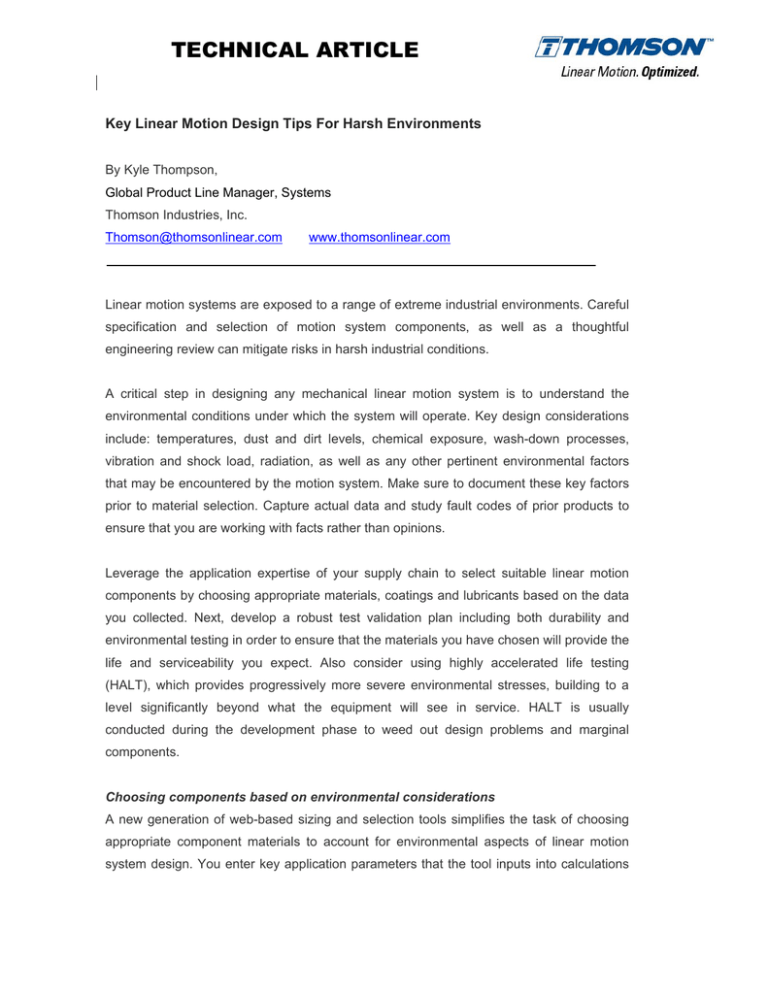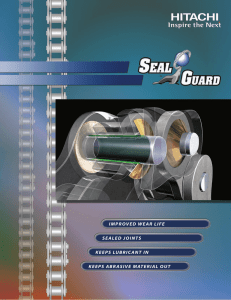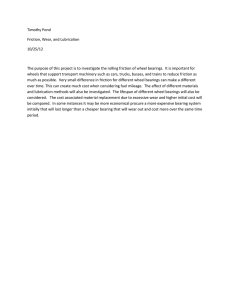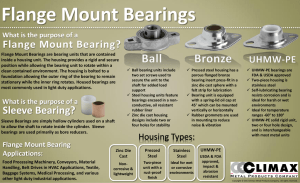Key Linear Motion Design Tips For Harsh Environments
advertisement

TECHNICAL ARTICLE Key Linear Motion Design Tips For Harsh Environments By Kyle Thompson, Global Product Line Manager, Systems Thomson Industries, Inc. Thomson@thomsonlinear.com www.thomsonlinear.com Linear motion systems are exposed to a range of extreme industrial environments. Careful specification and selection of motion system components, as well as a thoughtful engineering review can mitigate risks in harsh industrial conditions. A critical step in designing any mechanical linear motion system is to understand the environmental conditions under which the system will operate. Key design considerations include: temperatures, dust and dirt levels, chemical exposure, wash-down processes, vibration and shock load, radiation, as well as any other pertinent environmental factors that may be encountered by the motion system. Make sure to document these key factors prior to material selection. Capture actual data and study fault codes of prior products to ensure that you are working with facts rather than opinions. Leverage the application expertise of your supply chain to select suitable linear motion components by choosing appropriate materials, coatings and lubricants based on the data you collected. Next, develop a robust test validation plan including both durability and environmental testing in order to ensure that the materials you have chosen will provide the life and serviceability you expect. Also consider using highly accelerated life testing (HALT), which provides progressively more severe environmental stresses, building to a level significantly beyond what the equipment will see in service. HALT is usually conducted during the development phase to weed out design problems and marginal components. Choosing components based on environmental considerations A new generation of web-based sizing and selection tools simplifies the task of choosing appropriate component materials to account for environmental aspects of linear motion system design. You enter key application parameters that the tool inputs into calculations TECHNICAL ARTICLE such as linear bearing load/life, ball screw load/life, and ball screw critical speed. You also enter environmental conditions that are critical to choosing the right material, cover strategy, and lubrication scheme. For example, you can select: • Water/chemical spray/fog • Impact/press application/vibration • Moderate to heavy dust-particulate count • High pressure/temperature wash down • Water/chemical splash, • Clean room The application will recommend linear slide features — such as chrome plating, stainlesssteel components, or polymer plain bearings to address the environmental conditions. Component features The ball guide or bearing rail, shaft, or aluminum surface will support the bearing and is typically available in standard steel, stainless steel, Armoloy plated, or chrome plated. The linear bearings provide the load and moment load capability of the system. Examples include round rail Linear Ball Bushing bearings, profile rails, wheel-guides or polymer guides. Most are available as standard, corrosion resistant (“CR”) linear bearings or polymer plain bearings. Hardware options for the screws, bolts, and nuts that hold together the linear unit are usually available as standard or stainless steel. The sealing or protective covering for a linear unit provides options ranging from no cover at all, to bellows, shroud, or enclosed (ideal seal). Finally, standard grease or clean room grease options are available for lubrication within the linear unit. Round rail Linear Ball Bushing bearings, profile rails, wheel-guides or polymer guides are also available as corrosion resistant (“CR”) linear bearings or polymer plain bearings. They suit applications involving clean rooms, high temperature or wash down, chemical spray and fog, or chemical wash. 1 • Solutions by Environment: Clean—This environment is characterized as a machine shop setting. You can expect some airborne particles and some degree of humidity to be present; however, personnel would typically function in this environment without any form of protective gear (masks, respirators, local dust or chemical hoods). TECHNICAL ARTICLE Solution: • Ball Guide: Standard • Linear Bearing: Standard • Hardware: Standard • Cover: No cover • Lubrication: Standard grease Reason for this solution set: Standard aluminum and steel parts are acceptable in these environments as there is little concern for particulates or corrosion. 2 • Moderate to Heavy Dust Particulate Count—This environment is characterized by enough airborne particles to require an operator to wear some form of respiratory protection. Paper mills and factories with large industrial polishing machines are examples of environments under a heavy dust particulate count. Solution: • Ball Guide: Standard • Linear Bearing: Standard • Hardware: Standard • Cover: Enclosed (ideal), shroud or bellows may be acceptable • Lubrication: Standard Reason for this solution set: Standard steel components are acceptable since there is not a concern about corrosiveness. Rather, the concern is preventing an ingression of particulates into the bearing, ball guide tracks and drive mechanism (which may be a screw or belt). For large particles, a bellows cover or an aluminum shroud covering may be acceptable. For finer particles, the linear motion system should have a robust sealing system that protects the internal parts noted above. There are two options for such a seal. The first is a magnetic-strip seal that consists of stainless-steel magnetic bands extending from one end of the channel in the structural support system to the other. The bands are fixed to the end caps and spring-loaded to maintain tension. They run through a cavity in the carriage so the strip is raised off the magnets just ahead of and behind the carriage as it traverses the system. The second potential sealing technology, plastic cover bands, use compliant rubber strips that interlock with the base extrusion, like a zip-top freezer bag. TECHNICAL ARTICLE Mating tongue-and-groove profiles create a labyrinth seal that keeps out particulates. The sealing or protective covering for a linear unit includes no cover at all, bellows, shroud, or enclosed (ideal seal). Standard grease or clean room grease options are available for lubrication within the linear unit. 3 • Water / Chemical Splash — This environment represents a condition where product may be exposed to an intermittent splash of fluid. A large printing application, for example, where reservoirs of ink may be changed periodically resulting in occasional/accidental spillage. The contact of fluid with linear guides in this environment may be a result of mishandling product or out of position components but is typically not part of the normal application process. Solution: • Ball Guide: Chrome plated • Linear Bearing: Corrosion resistant • Hardware: Stainless steel • Cover: Enclosed (ideal) or bellows may be acceptable • Lubrication: Standard Reason for this solution set: For these applications, the ball guides and linear bearings must be corrosion resistant. For round rail bearing technology, this would mean either chrome-plated or 440C stainless steel shafting. Linear bearings should have chromeplated bearing plates and stainless steel balls. The softer stainless steel ball bearings and shafting typically results in a 30% load reduction, which must be considered as part of the design. For profile rail bearings, a thin-dense chrome plating, such as Duralloy, is recommended. Plain bearings, often referred to as prism-guides, are an alternative to rolling element bearings. The prism guides are an engineered polymer with high resistance to chemical corrosion. For sealing, bellows may be sufficient depending upon the severity of the chemical splash, but a completely sealed unit is ideal. 4 • Water Chemical Spray/Fog — This condition is a step above the previously described environment in terms of severity. Here a spray or fog is part of the process and the linear guides would be directly exposed to this element. This could also be characterized as a condensing environment similar to what is found in a refrigeration application. Coolant TECHNICAL ARTICLE misted on machine parts during processing is also part of this class. In this environment scenario, the bearing and guides will be in contact with fluid if no mechanical protection is offered. Solution: • Ball Guide: Chrome plated • Linear Bearing: Corrosion resistant • Hardware: Stainless steel • Cover: Enclosed • Lubrication: Standard Reason for this solution set: For these applications, a completely sealed unit is a must. Because of the severe nature of the chemical spray, it is also highly recommended to avoid rolling element bearing technology and use prism-guided bearings as noted previously. For the same reason, a ball screw drive system should be avoided when possible in these environments. Instead, a polyurethane belt-drive system will be better suited to handle the corrosive chemical environment. The ball guide or bearing rail and shaft are often available in standard steel, stainless steel, Armoloy plated, or chrome plated. These linear bearing components provide the load and moment load capability of the system. They suit applications such as standard machine shop, moderate to heavy dust particulate count, and impact press type applications with vibration. 5 • High Pressure Temperature/Wash down — This environment typically describes a food processing application. Here, equipment may be washed down, under pressure, quite frequently. Slides will not only be in contact with fluid but will also see considerable force from the cleaning process. Solution: • Ball Guide: Chrome plated • Linear Bearing: Corrosion resistant • Hardware: Stainless steel • Cover: No cover • Lubrication: Standard or, potentially, food-grade or high-temperature grease TECHNICAL ARTICLE Reason for this solution set: The wash-down environment will cause standard steel parts to rust. Chrome-plated and corrosion resistant bearings and ball guides should be used along with stainless steel hardware. Prism-guides can also be used, but should be avoided in high-temperature applications due to their polymer material, which is not as temperature resistant as metal based rolling elements. The linear unit should be open (no sealing) and have purge fittings or drain holes to remove wash-down fluid. For high-temperature applications, special high-temp grease can be used. In such high temperature cases, all seals and other plastic elements should be removed from the system. 6 • Clean Room — Here we are generally referring to about an ISO Class 3 (sometimes referred to as a Class1000) clean room environment, although some linear unit product families can be configured for a Class 100 clean room environment. Solution: • Ball Guide: Chrome plated • Linear Bearing: Corrosion resistant plus removal of seals/wipers • Hardware: Stainless steel • Cover: No cover • Lubrication: Clean room grease Reason for this solution set: For clean room environments, the linear slide must have minimal particulate resulting from its movement. Metal plating’s are needed to prevent any kind of rusting. There also needs to be removal of any sliding elements from the linear system. This means no seals/wipers in the bearings guides and no cover on the linear unit. Special clean-room rated grease should be used. 7 • Impact/Press App./Vibration — This application is often characterized by several different processes. Shakers and vibrating tables typically associated with sorting equipment fall under this category. Press applications that would impart higher than normal loads on carriages or saddles due to initial impact dynamics are considered part of this class of applications as well. Solution: • Ball Guide: Standard TECHNICAL ARTICLE • Linear Bearing: Polymer plain bearing • Hardware: Standard • Cover: Optional • Lubrication: Standard Reason for this solution set: The use of polymer style bushings, also called prism guides as noted earlier, handle high shock load applications better than rolling elements. Under such conditions, rolling elements may crack in half or jam the bearing rolling element tracks due to their point-to-point contacts with the bearing surface. Prism guides, however, allow for equal distribution of load along the plain surface, which is ideal for vibrations. The use of prism guides can be combined with a cover, if needed, depending upon the particulate count. Image captions for Thomson Linear Motion tips article Round rail Linear Ball Bushing bearings, profile rails, wheel-guides or polymer guides are also available as corrosion resistant (“CR”) linear bearings or polymer plain bearings. They suit applications involving clean rooms, high temperature or wash down, chemical spray and fog, or chemical wash. TECHNICAL ARTICLE The sealing or protective covering for a linear unit includes no cover at all, bellows, shroud, or enclosed (ideal seal). Standard grease or clean room grease options are available for lubrication within the linear unit. The ball guide or bearing rail and shaft are often available in standard steel, stainless steel, Armoloy plated, or chrome plated. These linear bearing components provide the load and moment load capability of the system. They suit applications such as standard machine shop, moderate to heavy dust particulate count, and impact press type applications with vibration. TECHNICAL ARTICLE Prism-guides should be avoided in high-temperature applications due to their polymer material, which is not as temperature resistant as metal based rolling elements Linear motion systems are exposed to a range of extreme industrial environments.



